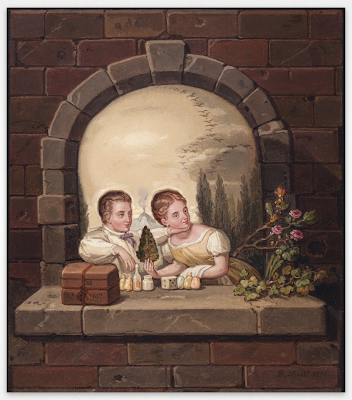Feast your eyes on new works added today to the Cultural Institute
December 10th, 2013 | Published in Google Blog
At the Cultural Institute we’ve been taking a break from our holiday shopping to feast our eyes on a different kind of gift—the gift of ingenious art that plays tricks on our eyes.
Called Trompe l'oeil, which means “fool the eye” in French, these techniques require complete control over every detail of size, color, light and gradation of color so that a two-dimensional work appears to be three-dimensional. You can see several examples amongst the new content being launched by 34 global partners today on the Cultural Institute and across our entire collection of more than 57,000 artworks.

Trompe l'oeil has been used on things as large as a ceiling—like this fresco at the National Archaeological Museum of Ferrara which uses clever architectural form to momentarily confuse:

And as small as a vase:

Sometimes the trickery lies in the deft organization of the elements in the picture, like this one. Can you find the secret image lurking within this seemingly innocent painting of a young man and woman?

Other new works exhibit a similar visual trickery. This relic from the Qing dynasty comes from the National Palace Museum of Taiwan—does the cabbage look good enough to eat?

Or take a look at the Musée d’Orsay’s exhibition of its unusual history, and then compare the details of the former station to the indoor Street View imagery of today's modern museum:


From Trompe l'oeil to archaeological artifacts, royal portraits and famous scientists, there’s a lot to discover in the latest collection, which comes from all over the world. Enjoyed the visual trickery? See what else can you spot and tell us your favorite examples on our Google+ page.
Called Trompe l'oeil, which means “fool the eye” in French, these techniques require complete control over every detail of size, color, light and gradation of color so that a two-dimensional work appears to be three-dimensional. You can see several examples amongst the new content being launched by 34 global partners today on the Cultural Institute and across our entire collection of more than 57,000 artworks.

Enter the wonderful world of Adriana Varejão—or not, it’s hard to tell. Varejão’s O Colecionador (Inhotim, Brazil)
Trompe l'oeil has been used on things as large as a ceiling—like this fresco at the National Archaeological Museum of Ferrara which uses clever architectural form to momentarily confuse:

Don’t drop that lute! Treasure Room Fresco, 1503-1506 (National Archaeological Museum of Ferrara, Italy)
And as small as a vase:

Manufacture royale de Sèvres: Vase "ferré" en première grandeur, Vers 1765-1770 (Ephrussi de Rothschild Villa & Gardens, Italy)
Sometimes the trickery lies in the deft organization of the elements in the picture, like this one. Can you find the secret image lurking within this seemingly innocent painting of a young man and woman?

Bernardino Montañés Pérez: Caprice, 1891 (Museo de Huesca, Spain)
Other new works exhibit a similar visual trickery. This relic from the Qing dynasty comes from the National Palace Museum of Taiwan—does the cabbage look good enough to eat?

Unknown: Jadeite Cabbage, Qing Dynasty (National Palace Museum, Taiwan)
Or take a look at the Musée d’Orsay’s exhibition of its unusual history, and then compare the details of the former station to the indoor Street View imagery of today's modern museum:

The station d'Orsay in its heyday. (Musée d’Orsay)

The Musée d’Orsay on Street View